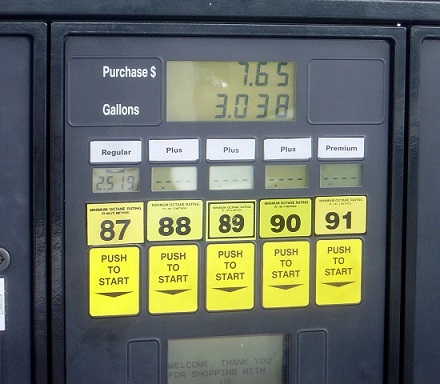Octane rating

Octane rating, also known as octane number is a measurement of the quality or performance of gasoline. The higher the number, the better the fuel burns within the engine of a vehicle. Higher performance vehicles require fuels with a higher octane rating.
The octane rating of a specific gasoline mixture is based off the ratios of two compounds in the gasoline—iso-octane, a compound with the same chemical formula as octane but with slightly different structure and properties (they are chemical isomers), and normal heptane. These two compounds outline the two extremes of the scale, with pure iso-octane having a rating of 100 and n-heptane having a rating of zero. Thus, a blend of 90% iso-octane and 10% n-heptane would have an octane rating of 90.[2]
The higher the octane number, the more compression from the piston the gasoline can withstand before igniting in the engine. The ability for gasoline to withstand being compressed is most important for vehicles that run on traditional gasoline. In contrast, diesel engines do not compress fuel but rather air and then inject fuel. These engines rely on different ratings, known as cetane numbers.[3]
Pre-Ignition and Knocking
The main difference between whether or not one uses high or low octane gasoline is determined by the level of "knocking" ones engine experiences. Inside the engine, an air-fuel mixture is ignited by the spark plug. While this is occurring, the piston is also moving upwards, compressing the air-fuel mixture and simultaneously increasing its temperature (since temperature increases as pressure increases). With lower octane fuels, the air-fuel mixture can also ignite due to this compression. When this flame front collides with the flame front ignited by the spark plug, an audible "knock" is heard. When the air-fuel mixture within an engine ignites due to compression rather than from the spark plug it is known as "pre-ignition"[4] If the fuel combusts and burns before it is ignited by the spark plug, it burns incompletely. The leftover fuel from this incomplete ignition causes residue to stick to the inside of the fuel chamber, eventually leading to the sounds from ones engine known as engine knock.[5]
For a helpful video explaining engine knock, click here.
Generally, the owners manual that comes with new vehicles has manufacturers recommendations as to which octane rating a vehicle should use to prevent this harmful pre-ignition and knocking due to build-up. Most auto manufacturers recommend 87 octane gasoline, but advise using a higher octane gasoline if knocking is an issue with the lower grade.[2]
For Further Reading
- Gasoline engine
- Diesel vs gasoline engine
- Hydrocarbon combustion
- Greenhouse gas emission
- Or explore a random page
References
- ↑ "Gas Station Pump Five Octane Ratings" by Original uploader was Bobak at en.wikipedia - Transferred from en.wikipedia; transfer was stated to be made by User:Matt.T.. Licensed under CC BY-SA 2.5 via Wikimedia Commons - http://commons.wikimedia.org/wiki/File:Gas_Station_Pump_Five_Octane_Ratings.jpg#mediaviewer/File:Gas_Station_Pump_Five_Octane_Ratings.jpg
- ↑ 2.0 2.1 Petro-Canada. (2015). Octane & Other Gasoline Basics [Online]. Available: http://retail.petro-canada.ca/en/independent/2069.aspx [February 16, 2015].
- ↑ Christine & Scott Gable. (2015). What is Cetane? [Online]. Available: http://alternativefuels.about.com/od/researchdevelopment/a/cetane.htm [February 16,2015].
- ↑ Bell Performance. (2015). What Does Octane Do? [Online]. Available: http://www.bellperformance.com/blog/bid/101182/What-Does-Octane-Do-In-Gasoline-Octane-Ratings [February 16, 2015].
- ↑ Cherise LaPine. (2011). Causes of Engine Knock [Online]. Available: http://auto.howstuffworks.com/engine-knock1.htm [February 16, 2015].

